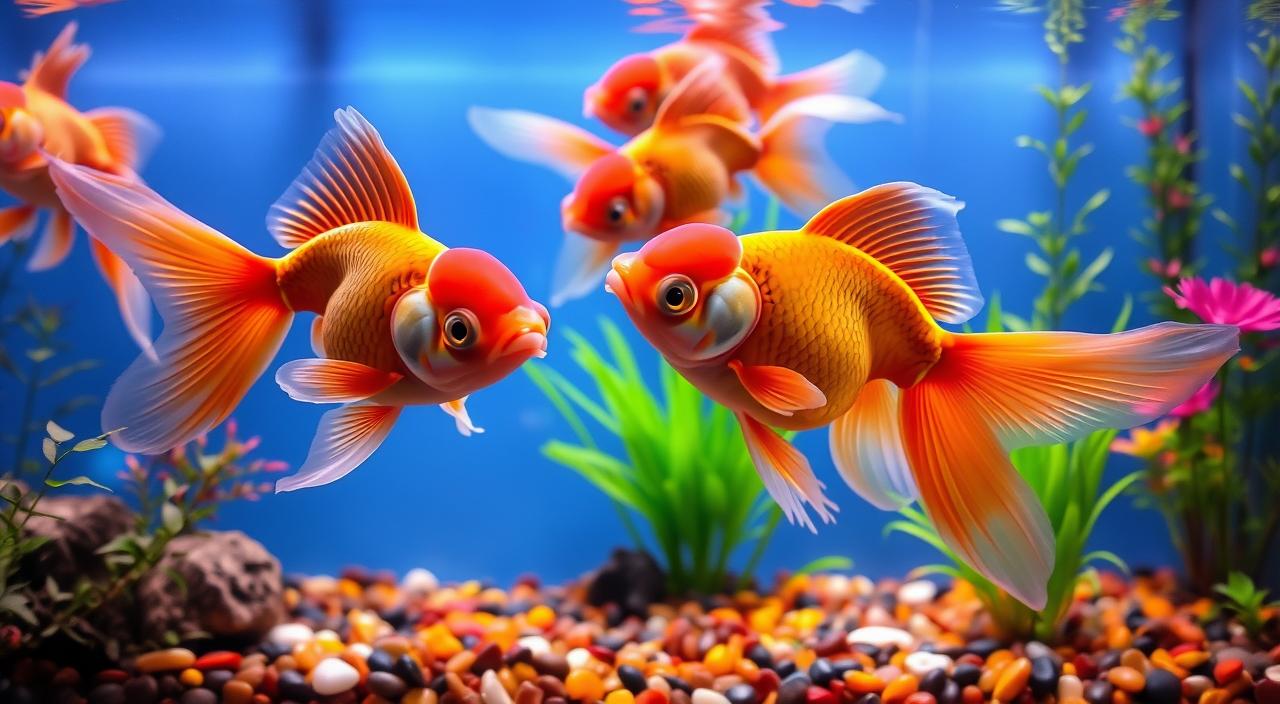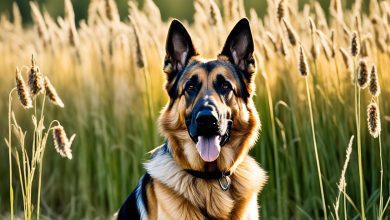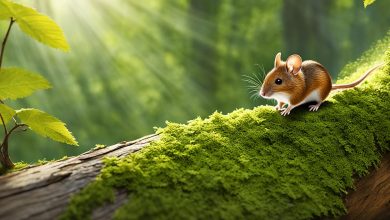Oranda goldfish are truly mesmerizing creatures. Their graceful movements and distinctive features captivate aquarium enthusiasts worldwide. These enchanting pets bring joy and wonder to their caretakers.
Orandas stand out with their unique “wen” or hood-like growth on their heads. Their round bodies and elegant fins make them a gem among ornamental fish. These gentle creatures are prized for both their appearance and nature.
Orandas have become beloved pets in the aquarium hobby. Their distinctive traits and care needs make them fascinating to both new and experienced fish keepers. Let’s explore what makes these fancy goldfish so special.
Introduction to Oranda Goldfish: A Fanciful Aquatic Wonder
Oranda goldfish captivate aquarium lovers with their enchanting looks. They have a fleshy growth on their heads called a wen. This cap-like feature gives them a regal appearance, earning the nickname “crowned goldfish.”
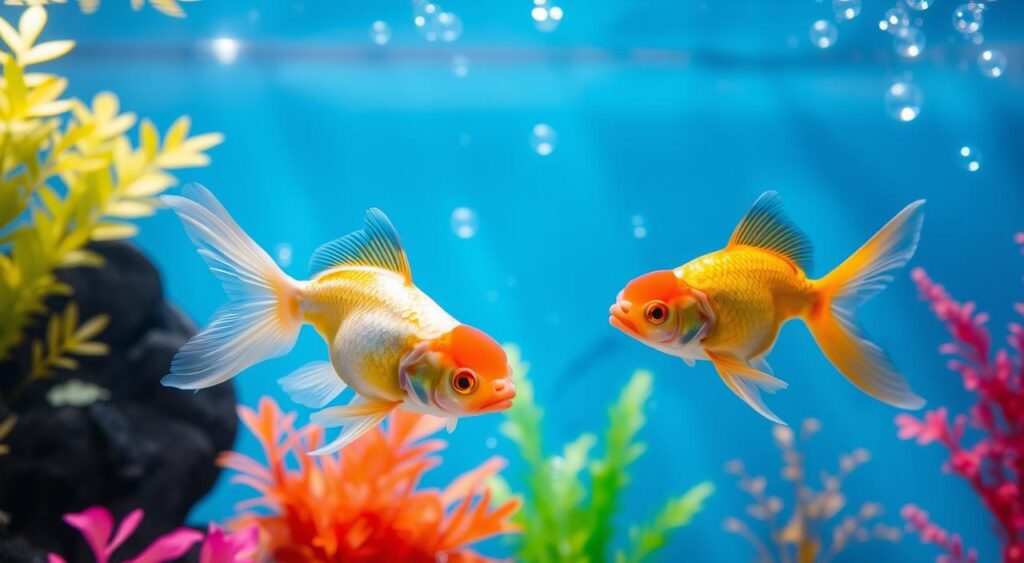
Selective breeding in China created these beloved fish. They come in various colors, including red, black, white, and calico patterns. Their unique look and gentle nature make them popular worldwide.
Oranda goldfish belong to the fancy goldfish family. They have rounded bodies and flowing fins. Their graceful moves create a mesmerizing sight in home aquariums.
“Oranda goldfish are like living jewels, adding a touch of elegance to any aquarium setup.”
Caring for oranda goldfish needs attention to detail. They need well-kept tanks with good filtration and regular water changes. These fish like cooler water and a diet of quality pellets and fresh veggies.
| Characteristic | Description |
|---|---|
| Size | 6-7 inches |
| Lifespan | 10-15 years |
| Tank Size | 20+ gallons |
| Water Temperature | 65-72°F (18-22°C) |
Oranda goldfish need specific care but offer great rewards. Their charm and striking looks make them perfect for new and experienced fish keepers. These fish bring wonder to any home aquarium.
The Distinctive Features of Oranda Goldfish
Oranda goldfish dazzle aquarium fans with their unique look. These fancy goldfish have several striking features that set them apart. Their appearance makes them a favorite among fish lovers.
The Iconic Wen or Hood
The wen, a fleshy growth on the head, is the oranda’s standout trait. This hood-like feature grows as the fish ages, creating a cap-like look. Unlike lionhead goldfish, orandas have a more balanced wen growth.
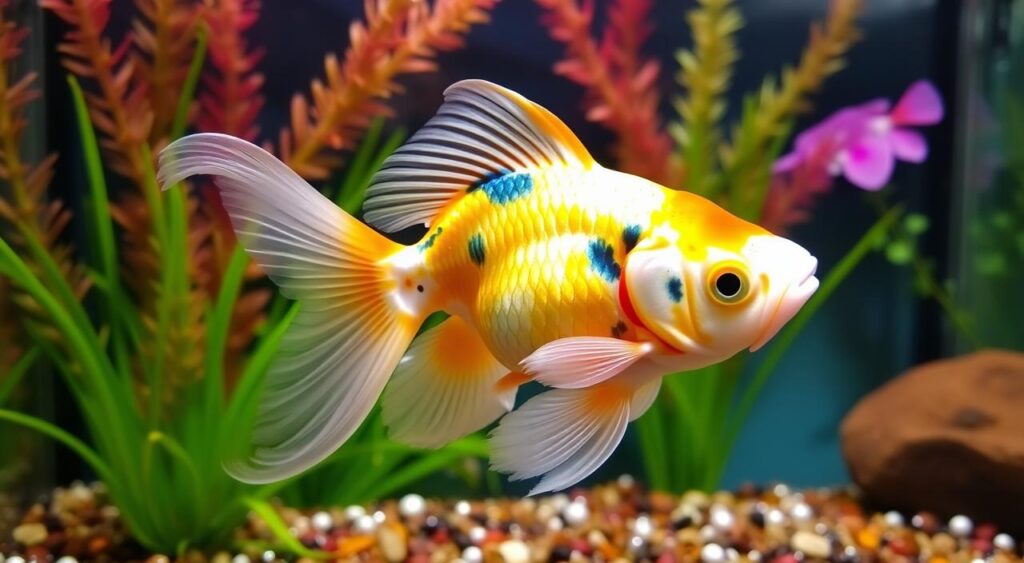
Body Shape and Finnage
Orandas have a round, egg-shaped body with a split tail fin. Their flowing fins add grace to their look. The dorsal fin stands tall, while other fins are long and elegant.
Color Varieties and Patterns
These goldfish come in many colors, including red, black, blue, and white. The calico pattern, with orange, black, and white, is highly valued. Some orandas even have metallic scales, making them more appealing.
| Feature | Oranda Goldfish | Lionhead Goldfish |
|---|---|---|
| Wen Growth | Balanced, covering head | Prominent, raspberry-like |
| Body Shape | Egg-shaped | Round |
| Dorsal Fin | Present | Absent |
These features make oranda goldfish a stunning addition to any aquarium. They appeal to both new and experienced fish keepers. Their unique looks never fail to impress.
Origins and History of the Oranda Goldfish Breed
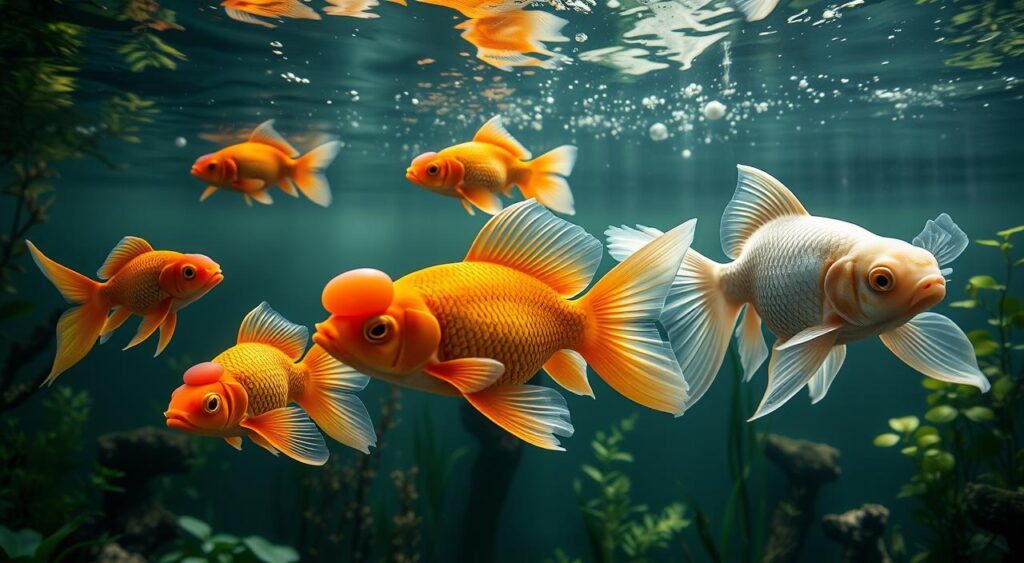
Oranda goldfish originated in ancient China. They came from selective breeding of carp during the Ming Dynasty (1368-1644). Chinese breeders aimed to create unique ornamental fish.
The oranda’s signature feature is the wen or hood. This fleshy growth on the head became highly valued. Breeders improved the oranda’s look over time.
Fancy goldfish, including orandas, reached Japan in the 1600s. Japanese breeders created new color patterns and refined the wen. Orandas became symbols of good fortune in both countries.
“Oranda goldfish represent centuries of careful breeding and cultural significance in East Asia.”
Western countries discovered these fish in the 1800s. Orandas quickly gained fans in Europe and North America. They became popular in the aquarium hobby.
Today, orandas are beloved worldwide. People cherish them for their unique looks and gentle nature. They remain one of the most popular fancy goldfish varieties.
Caring for Your Oranda Goldfish: Tank Setup and Maintenance
Oranda goldfish need special care to thrive in captivity. A well-planned tank setup and regular upkeep are vital. These steps help them stay healthy and show off their beautiful features.
Ideal Tank Size and Environment
One oranda goldfish needs at least 20 gallons of water. Add 10 gallons for each extra fish. Use smooth gravel and live plants to decorate the tank.
Avoid sharp objects in the tank. These can hurt the fish’s delicate fins.
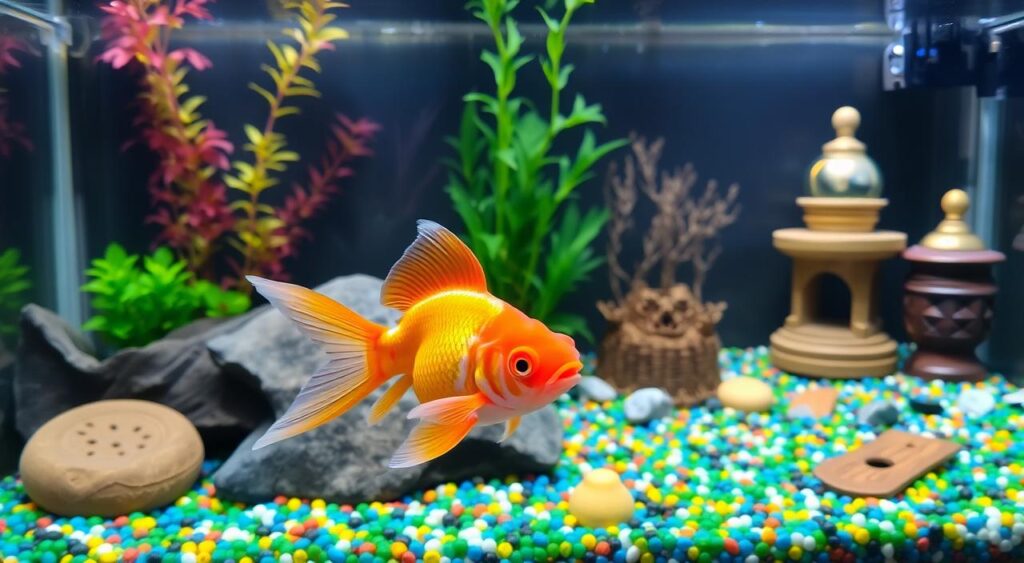
Water Quality and Filtration
Oranda goldfish produce a lot of waste. Use a powerful filter rated for twice your tank’s volume. Do weekly water changes of 25-30% to keep the water clean.
Test water parameters often. This ensures the best conditions for your fish.
Temperature and pH Requirements
Keep water temperature between 65-72°F (18-22°C). Oranda goldfish like slightly alkaline water with a pH of 7.0-8.0. Use a good thermometer and pH test kit regularly.
| Parameter | Ideal Range |
|---|---|
| Temperature | 65-72°F (18-22°C) |
| pH | 7.0-8.0 |
| Ammonia | 0 ppm |
| Nitrite | 0 ppm |
| Nitrate | <40 ppm |
Follow these tips to create a cozy home for your oranda goldfish. Your fish will live longer and be happier in their well-maintained aquarium.
Oranda Goldfish Diet and Nutrition
Oranda goldfish need a careful diet for optimal health. They thrive on varied foods, including plant and animal sources. High-quality flakes, pellets, and frozen foods provide essential nutrients for growth.
These fancy fish are omnivores with diverse tastes. Their ideal menu includes:
- Commercial goldfish flakes or pellets
- Frozen bloodworms or brine shrimp
- Blanched vegetables like spinach or lettuce
- Live foods such as daphnia or tubifex worms
Feed your oranda small portions 2-3 times daily. This schedule mimics their natural grazing habits. It also prevents overfeeding, which can cause health problems.
| Food Type | Frequency | Benefits |
|---|---|---|
| Flakes/Pellets | Daily | Balanced nutrition |
| Frozen Foods | 2-3 times weekly | Protein boost |
| Vegetables | 1-2 times weekly | Fiber and vitamins |
| Live Foods | Occasional treat | Natural foraging behavior |
Oranda goldfish have small stomachs compared to their body size. Overfeeding can lead to bloating and swim bladder issues. Always remove leftover food after feeding to keep the water clean.
Breeding Oranda Goldfish: Tips and Challenges
Oranda goldfish breeding offers a fulfilling challenge for aquarium lovers. These unique fish need special care during breeding. Let’s dive into the key steps for breeding orandas successfully.
Selecting Breeding Pairs
Pick healthy, mature orandas for breeding. Seek fish with bright colors, well-formed wen, and strong fins. Good breeding pairs should be at least two years old.
Look for fish showing signs they’re ready to spawn. This ensures a higher chance of breeding success.
Creating the Right Breeding Conditions
Set up a separate breeding tank with soft, slightly acidic water. Slowly raise the water temperature to encourage spawning. Add plants or spawning mops for egg-laying.
Keep the water quality excellent throughout breeding. This helps ensure healthy eggs and fry.
Caring for Fry and Juvenile Orandas
After eggs hatch, remove adult fish to protect the fry. Feed baby orandas special fry food and change water often. As they grow, start giving larger food bits.
Watch their growth closely. This helps catch any problems early on.
| Breeding Stage | Temperature | Water pH | Feeding Frequency |
|---|---|---|---|
| Conditioning | 68-72°F | 7.0-7.5 | 3-4 times daily |
| Spawning | 72-75°F | 6.8-7.2 | 2-3 times daily |
| Fry Rearing | 70-74°F | 7.0-7.5 | 4-6 times daily |
Breeding orandas takes time and effort. Following these tips boosts your chances of raising beautiful new goldfish. With patience, you’ll soon have a tank full of stunning orandas.
Common Health Issues and How to Prevent Them
Oranda goldfish face unique health challenges. Knowing these issues helps fish owners provide better care. This knowledge ensures the well-being of these fancy goldfish.
Swim bladder disorder often affects oranda goldfish. It makes swimming and balance difficult. Avoid overfeeding and soak dry foods to prevent this problem.
Fin rot damages the delicate fins of fancy goldfish. Poor water quality usually causes this condition. Prevent fin rot with regular tank cleaning and proper filtration.
Ich appears as white spots on the fish’s body. It’s a parasitic infection. Quarantine new fish and keep water temperatures stable to avoid ich outbreaks.
| Health Issue | Symptoms | Prevention |
|---|---|---|
| Swim Bladder Disorder | Floating upside down, swimming sideways | Balanced diet, avoid overfeeding |
| Fin Rot | Frayed, discolored fins | Regular water changes, proper filtration |
| Ich | White spots on body and fins | Quarantine new fish, stable water temperature |
Watch your oranda goldfish closely for signs of illness. Act quickly if you notice any problems. With proper care, these charming fish can thrive for years.
Comparing Oranda Goldfish to Other Fancy Goldfish Varieties
Oranda goldfish are one of many captivating fancy goldfish varieties. Each type has its own unique appeal and specific care requirements.
Ranchu and Lionhead Goldfish
Ranchu and Oranda goldfish both have prominent head growths. Ranchus have rounder bodies and no dorsal fin, giving them an egg-like shape.
Lionheads are similar to Orandas but have a more pronounced wen. This growth covers their entire head and cheeks.
Bubble Eye and Telescope Eye Goldfish
Bubble eye goldfish have fluid-filled sacs under their eyes. These sacs need extra care to prevent damage.
Telescope eye goldfish have protruding eyes that are more sensitive than Orandas’. Both types require special attention during tank cleaning.
Calico and Pompon Goldfish
Calico goldfish display a beautiful mix of orange, black, and white scales. Pompon goldfish have unique nasal growths that look like fluffy balls.
Orandas can have various colors but lack these specific traits. Each variety offers its own distinct charm.
| Goldfish Type | Unique Feature | Care Level |
|---|---|---|
| Oranda | Wen (head growth) | Moderate |
| Ranchu | Egg-shaped body | Moderate |
| Bubble Eye | Fluid-filled sacs | High |
| Telescope Eye | Protruding eyes | High |
| Pompon | Nasal growths | Moderate |
Oranda Goldfish in Aquascaping: Creating a Beautiful Habitat
Oranda goldfish are stunning centerpieces in well-designed aquascapes. Their flowing fins and distinctive wen create a captivating focal point. When planning your aquarium, consider the needs of these fancy goldfish.
Choose plants that complement oranda goldfish. Opt for sturdy varieties like Anubias, Java fern, or Amazon sword. These plants withstand curious nibbling and provide natural hiding spots.
Floating plants like duckweed or water lettuce offer shade. They also help maintain water quality in your aquarium.
Use smooth decorations to protect the oranda’s delicate fins. Large river rocks, driftwood, and ceramic ornaments create interesting landscapes. Arrange these elements to form caves and tunnels for exploration and rest.
- Use fine, smooth substrate to protect the oranda’s sensitive barbels
- Create open swimming areas for the goldfish to display their graceful movements
- Install a gentle filtration system to maintain water clarity without stressing the fish
Lighting is crucial in showcasing your oranda goldfish. Use soft, diffused lighting to highlight their vibrant colors without causing stress. LED lights with adjustable settings create the perfect ambiance for your aquascape.
“A well-designed aquascape not only enhances the beauty of oranda goldfish but also promotes their health and well-being.”
While aesthetics are important, prioritize the comfort and safety of your fancy goldfish. Create an underwater home that balances beauty and well-being.
The Popularity of Oranda Goldfish in the Aquarium Hobby
Oranda goldfish have captivated aquarium lovers worldwide. Their unique wen, or head growth, charms both new and experienced fish keepers. These fancy goldfish add elegance to tanks with their graceful appearance.
Orandas stand out among other fancy goldfish varieties. They adapt well to different tank setups and are relatively hardy. Many hobbyists find the wen’s growth patterns fascinating, giving each fish a distinct look.
Oranda goldfish often star in public aquariums and competitions. This exposure has led to many color variations in the aquarium trade. From solid golds to calicos, there’s an oranda for every taste.
The oranda goldfish remains a beloved aquarium staple. Its unique features, manageable care, and stunning looks ensure its popularity. Fancy goldfish fans will cherish orandas for years to come.
